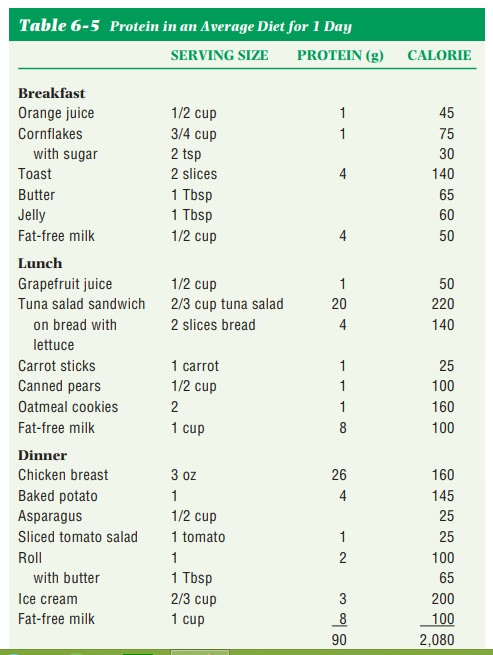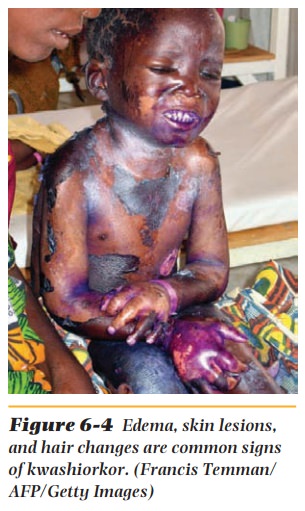Chapter: Nutrition and Diet Therapy: Proteins
Dietary Requirements of Proteins
DIETARY REQUIREMENTS
One’s protein
requirement is determined by size, age, sex, and physical and emotional
conditions. A large person has more body cells to maintain than a small person.
A growing child, a pregnant woman, or a woman who is breastfeeding needs more
protein for each pound of body weight than the average adult. When digestion is
inefficient, fewer amino acids are absorbed by the body; consequently the
protein requirement is higher. This is sometimes thought to be the case with
the elderly. Extra proteins are usually required after surgery, severe burns,
or during infections in order to replace lost tissue and to manufacture
antibodies. In addition, emotional trauma can cause the body to excrete more
nitrogen than it normally does, thus increasing the need for protein foods.
The National Research
Council of the National Academy of Sciences con-siders the average adult’s
daily requirement to be 0.8 gram of protein for each kilogram of body weight.
To determine your requirement, do the following:
· Divide body weight by
2.2 (the number of pounds per kilogram).
· Multiply the answer
obtained in step 1 by 0.8 (gram of protein per kilogram of body weight).
In 2002 the Dietary Reference Intakes (DRIs) for protein were published by the National Academy of Sciences (see Table 6-4). An Adequate Intake (AI) was established for infants 0 to 6 months, with all other recommendations based on 0.8 g/kg of body weight. Table 6-5 provides an idea of the amount of protein in an average day’s diet. (For specific amounts of protein in other foods, refer to Appendix D.)


Protein Excess
It is easy for people
living in the developed parts of the world to ingest more protein than the body
requires. There are a number of reasons why this should be avoided. The saturated
fats and cholesterol common to complete protein foods may contribute to heart
disease and provide more calories than are desirable. Some studies seem to
indicate a connection between long-term high-protein diets and colon cancer and
high calcium excretion, which de-pletes the bones of calcium and may contribute
to osteoporosis. People who eat excessive amounts of protein-rich foods may
ignore the also essential fruits and vegetables, and excess protein intake may
put more demands on the liver (which converts nitrogen to urea) and the kidneys
to excrete excess urea than they are prepared to handle. Therefore, the
National Research Council recommends that protein intake represent no more than
15% to 20% of one’s daily calorie intake and not exceed double the amount given
in the table of DRIs (Table 6-4).
Protein and Amino Acid Supplements
Protein and amino acid
supplements are taken for a number of reasons, such as “bulking up” by
athletes, growing fingernails, and sparing body protein in weight loss. It is
weight lifting, not protein bars or protein supplements, that builds muscles.
Fingernails have never been affected by extra protein, and dieters need a
balanced diet using the guidelines of MyPyramid.
High-quality protein
foods are more bioavailable than expensive sup-plements. Single amino acids can
be harmful to the body and never occur naturally in food. The body was designed
to handle food, not supplements. If a single amino acid has been recommended,
it is very important that a physician be consulted before the amino acid is
used.
Nitrogen Balance
Protein requirements
may be discussed in terms of nitrogen balance. This occurs when
nitrogen intake equals the amount of nitrogen excreted. Posi-tive nitrogen balance exists when nitrogen
intake exceeds the amountexcreted. This indicates that new tissue is being
formed, and it occurs dur-ing pregnancy, during children’s growing years, when
athletes develop additional muscle tissue, and when tissues are rebuilt after physical trauma such as illness or
injury. Negative nitrogen
balance indicates that protein is being lost. It may be caused by
fevers, injury, surgery, burns, starvation, or immobilization.
Protein Deficiency
When people are unable
to obtain an adequate supply of protein for an extended period, muscle wasting
will occur, and arms and legs become very thin. At the same time, albumin (protein in blood
plasma) deficiency will cause edema, resulting in an extremely swollen
appearance. The water is excreted when sufficient protein is eaten. People may
lose appetite, strength, and weight, and wounds may heal very slowly. Patients
suffering from edema become lethar-gic and depressed. These signs are seen in
grossly neglected children or in the elderly, poor, or incapacitated. It is
essential that people following vegetarian diets, especially vegans, carefully
calculate the types and amount of protein in their diets so as to avoid protein
deficiency.
Protein Energy Malnutrition (PEM)
People suffering from protein energy malnutrition (PEM) lack both protein and
energy-rich foods. Such a condition is not uncommon in developing coun-tries
where there are long-term shortages of both protein and energy foods. Children
who lack sufficient protein do not grow to their potential size. Infants born
to mothers eating insufficient protein during pregnancy can have perma-nently
impaired mental capacities.
Two deficiency
diseases that affect children are caused by a grossly inad-equate supply of
protein or energy or both. Marasmus, a condition resulting
from severe malnutrition, afflicts very young children who lack both energy and
protein foods as well as vitamins and minerals. The infant with marasmus
appears emaciated but does not have edema. Hair is dull and dry, and the skin
is thin and wrinkled (Figure 6-3). The other protein deficiency disease that
affects children as well as adults is kwashiorkor (Figure 6-4). Kwashiorkor appears when there is
a sudden or recent lack of protein-containing food (such as during a famine).
This disease causes fat to accumulate in the liver, and the lack of protein and
hormones results in edema, painful skin lesions, and changes in the
pigmentation of skin and hair. The mortality rate for kwashiorkor patients is
high.


Those who survive
these deficiency diseases may suffer from permanent mental
retardation. The ultimate cost of food deprivation among youngchildren is
high, indeed.
Table 6-6 lists some
signs that help distinguish marasmus from kwashiorkor.

Related Topics